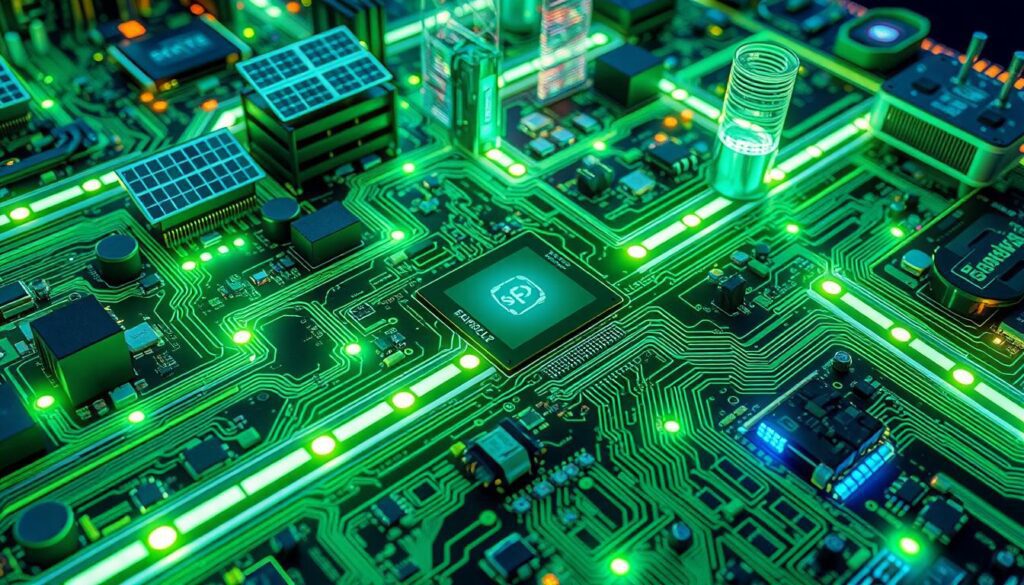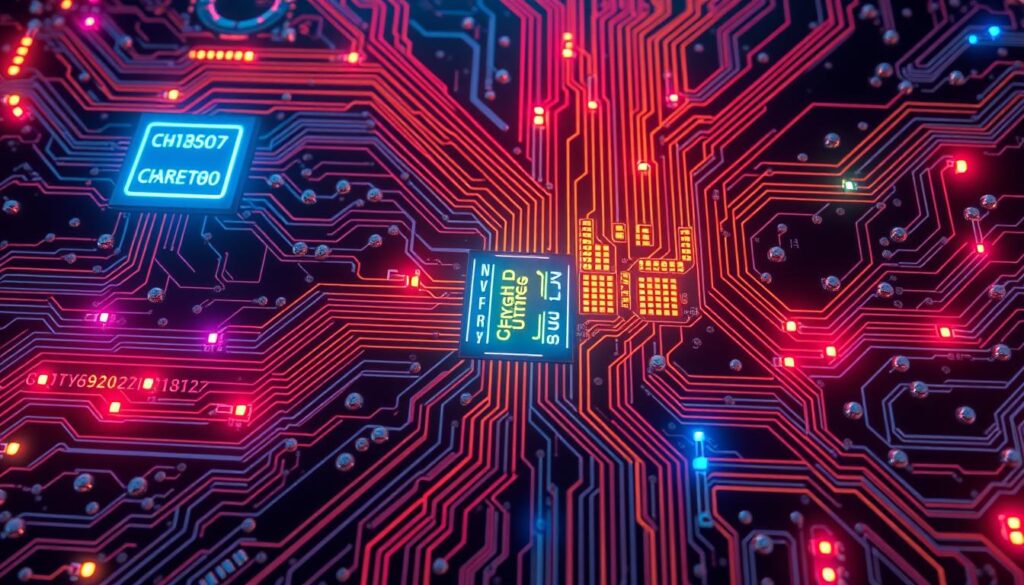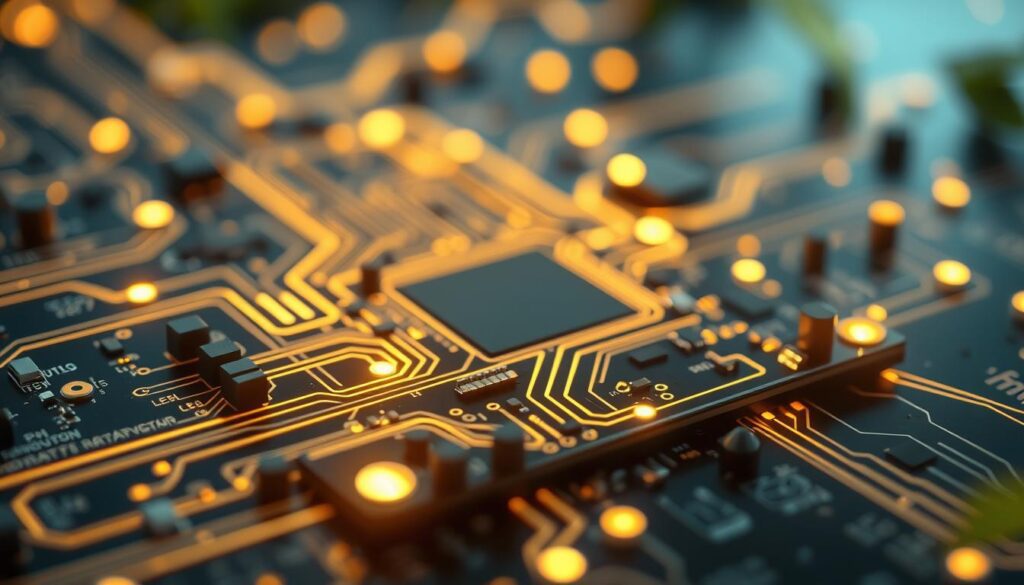In today’s world, making devices use less power is key. As gadgets get smarter and need more energy, saving power is a big deal. We’ll look at how to make low-power electronics work better.
Power efficiency is important for our planet and our wallets. It helps cut down on pollution, saves money, and makes batteries last longer. This is why making devices use less power is so important.
In this article, we’ll dive into the main ideas and new tech for power-saving gadgets. We’ll cover everything from basic power use to advanced ways to manage it. Our aim is to show you how to make devices use less power.
Table of Contents
Understanding Power Consumption Fundamentals in Modern Electronics
As technology advances, knowing how power is used in electronic devices is key. We’ll explore the basics of static power, dynamic power, and power density. These concepts are vital for making CMOS-based systems more energy-efficient.
Static Power Consumption and Leakage Current
Static power is the power used by a circuit when it’s not switching. It’s mainly due to leakage current, a trait of CMOS transistors. Reducing leakage current is a big challenge as devices get smaller. It’s essential for making devices power-efficient.
Dynamic Power Consumption in Digital Circuits
Dynamic power is used when digital circuits switch. It depends on the capacitance, supply voltage, and how often they switch. Cutting down dynamic power helps batteries last longer and keeps devices cool.
Power Density Considerations
As chips get smaller, power density becomes a big issue. High power density means more heat, which can harm device performance and lifespan. We need good ways to manage heat and power to tackle these problems.
| Power Consumption Type | Description | Factors Affecting |
|---|---|---|
| Static Power | Power consumed even when the circuit is not switching | Leakage current, transistor characteristics |
| Dynamic Power | Power consumed during active switching of digital circuits | Capacitance, supply voltage, switching frequency |
| Power Density | Power consumed per unit area of the chip | Chip design, thermal management |
Understanding static power, dynamic power, and power density helps us improve electronic devices. We can make them more efficient, reliable, and last longer.
Power Optimization in PD: Essential Techniques and Strategies
In the quest for energy-efficient circuits, we must explore key techniques in physical design (PD). These methods help reduce power consumption in low-power designs. This section covers the main power optimization strategies used by designers.
Transistor sizing is a crucial approach. It involves adjusting transistor sizes to balance performance and power. By optimizing transistor dimensions, we can cut down on static power losses. This is done while keeping the necessary switching speeds and dynamic power efficiency.
Threshold voltage (Vt) optimization is another important technique. Adjusting the Vt of transistors helps balance performance and power. This fine-tuning enables us to create energy-efficient circuits that are fast yet power-conscious.
Power-aware placement and routing are also key. By carefully placing and connecting circuit elements, we reduce dynamic power dissipation. This approach ensures the physical design meets power-aware goals.

By applying these power-aware design principles, we can achieve significant power savings. These essential techniques help us unlock the full potential of energy-efficient circuits. They pave the way for a more sustainable and power-conscious future in electronics.
Clock Gating and Voltage Scaling Methodologies
In the world of low-power designs, two key techniques stand out: clock gating and dynamic voltage and frequency scaling (DVFS). These methods help save energy by controlling clock speed and voltage. This leads to big power savings in today’s electronics.
Implementing Effective Clock Gating Solutions
Clock gating is a popular method that turns off the clock signal to idle parts of the circuit. This cuts down on power use. By managing clock domains well, we can save a lot of power. It’s all about analyzing the circuit and placing clock gating logic wisely.
Dynamic Voltage and Frequency Scaling Benefits
Dynamic voltage and frequency scaling (DVFS) is another key tool. It changes the voltage and clock speed based on how much work the circuit is doing. By lowering voltage and speed when not needed, we save a lot of power without losing performance.
Power State Management Techniques
- Good power state management is key for power efficiency. It means moving the system between active, idle, and sleep modes as needed.
- Using these techniques well helps us save power when the system is idle. This boosts the energy efficiency of low-power designs.
By combining clock gating, DVFS, and power state management, we can make low-power designs much more efficient. This leads to better energy use and longer battery life in many electronic devices.

Advanced Power Management Technologies
We’re looking into new ways to save power in today’s gadgets. We’re talking about cutting-edge power management tech. These include dividing up power domains and using multi-voltage designs. These methods are key to making devices more energy-efficient.
Power Domain Partitioning
Power domain partitioning is a big deal. It lets us split a chip or system into different power areas. This way, we can turn off or lower the voltage in certain parts. It helps cut down power use without hurting the device’s main functions.
Multi-Voltage Design
Multi-voltage design is another important tool. It uses different voltages for different parts of a chip. This lets us adjust the voltage to fit each block’s needs. It helps us find the right balance between power use and performance.
Power Gating Techniques
Power gating is great for reducing static power use. It works by adding special switches to turn off unused parts. This cuts down on power use in those areas.
Adaptive Voltage Scaling
Adaptive voltage scaling is all about dynamic power saving. It watches how the system is doing and changes the voltage as needed. This way, we save power without losing performance or speed.
These advanced power management techs are essential for the next big leap in energy-saving gadgets. By using these strategies, we can make devices more efficient. This leads to a greener future for electronics.
Design Verification and Power Analysis Tools
In the world of low-power design, power analysis software and simulation tools are key. They help engineers guess how much power a design will use. They also check if power-saving plans work and if the design is energy-efficient.
Power analysis software gives a detailed look at power use. It helps designers spot and fix high power spots. These tools use smart algorithms to figure out static and dynamic power, and leakage current. This lets engineers make smart choices and apply specific power-saving methods.
Simulation tools let designers check how their designs perform and use power under different conditions. By doing detailed power simulations, engineers can see if power-saving methods like clock gating and voltage scaling work. This ensures the product meets its power goals.
Also, advanced verification techniques like power-aware formal verification and simulation find power issues early. This way, designers can make changes quickly. It makes sure the design works right and uses less energy.
Using these tools and methods, design teams can tackle the tough task of power optimization. They create low-power solutions that meet today’s high electronics standards.
Key Features of Power Analysis Software and Simulation Tools
- Accurate power modeling and estimation capabilities
- Support for static and dynamic power analysis
- Integration with power-aware design and verification flows
- Intuitive user interfaces for easy power optimization
- Advanced power simulation and reporting capabilities
- Seamless integration with existing design tools and flows
| Power Analysis Software | Simulation Tools |
|---|---|
| Synopsys Power Compiler | Cadence Virtuoso Analog Design Environment |
| Mentor Graphics PowerPro | Ansys RedHawk |
| Cadence Joules | Synopsys PrimeTime |
Future Trends in Power Optimization for Low-Power Designs
Technology keeps getting better, leading to new ways to save power in devices. AI is playing a big role in making electronics more efficient and green.
AI and machine learning are now part of power management systems. They help devices use less energy by learning and adapting. This means devices can work better and use less power, helping the planet.
New power management tech is also on the rise. It includes better power conversion, energy storage, and wireless charging. These advancements make devices smaller, more flexible, and last longer. They also meet the needs of mobile, wearable, and IoT tech that need to be energy-smart.

